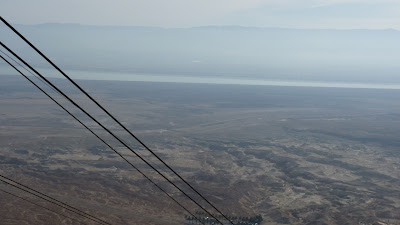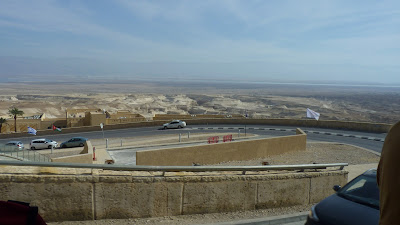The desert headed to the Dead Sea region. I think the white spot on the mountain is the reflection in the bus window.
The ever present lamp posts even in the desert.
lots of rocks are in the desert.
But, finally we arrived at the Dead Sea.
The Dead Sea is the lowest land site on earth. The sea is 33% salt.
No life is in the Dead Sea. It is important to Israel because they harvest chemicals from the water.
The mountains across the way are in Jordan.
Morning over the Dead Sea. Blue fading into blue.
The Dead Sea is shrinking about a meter a year. Our guide told us that these hills used to be under water.
The desert had very dramatic hills. These were on the other side of the road from the Dead Sea.
And finally we arrived at Masada, our morning destination.
This is a model of Masada. It was a palace/ fortress built on top of a mountain in the desert by Herod the Great. I read that there was no evidence that Herod was ever there. He was big on building palaces. After Herod died, it was still a fortress. In the uprising of the Jews against the Romans in about 70 AD some of the last survivors fled to Masada.
And then we were headed up the mountain.
The Romans built a wall around the mountain to prevent escape. They also built fortresses in the valley below Masada.
We rode a cable car up the mountain. I suspect the Jewish rebels didn't have it so easy. The Dead Sea is visible in the distance.
But even at the end of the cable car ride, we had some climbing to do.
There has been a lot of digging and discovering at the site. I am sure it was relatively undisturbed because of the location.
The palace built by Herod was elaborate. I can't imagine how hard it must have been to build such a fortress in such a hot dry climate. The big rectangles in the center of the model were storage for food and other needed supplies. They were huge.
This is one of those storage rooms as it stands today. The blue line shows where the original standing structure was and the part above is a reconstruction.
This is an explanation about how they survived on this mountain top for years.
Everything that was needed was stored up there.
They even decorated with mosaics.
This piece shows how the rooms were decorated.
And the bathes where hot water ran below the floor were built up there in that palace.
This was like a steam bath.
Looking out at the Dead Sea from Masada.
The line below shows the fortification that was built around the mountain.
This model shows how Herod's Palace draped down the mountain.
The center shows another Roman fortification as the Romans patiently worked to defeat the Jews.
And a closer look. Someday the archaeologists will get around to constructing this.
The lines of trees show where springs went along the valley.
Not an inviting mountain to climb.
We stopped at this point to discuss what happened at Masada. The Romans patiently attacked the fortress. They realized that they had to get up there to defeat the Jews.
The Roman Legions had a earthworks built up to the fortress. When the Jews realized that they were defeated, they chose some of there group to murder the rest of the group. A small handful of survivors hid and that is how the story is known.
This was the roof of the room where we listened to the story. It doesn't rain much there, so most days that is probably enough roof in the desert.
You might be asking about water up there. There were several cisterns.
The cisterns were hewn out of rock and lined with plaster.
This is just one of the cisterns. It was huge.
And while we were observing the cisterns and water system, this little bird decided to join the group.
He looks like a cowbird, but I am not sure.
He acted almost tame. I suppose he survives off tourists because there can't be much in the desert for him.
This demonstration of how water was collected for the fortress is what we were looking at when the bird joined us. I bet he has heard the story many times.
Water was collected from rainwater and channeled to the cisterns.
Explaining the dovecote. But, much too small to read.
This is what defeated Masada. Over a period of years the Romans had their Jewish slaves built this earthworks up the Masada. Because Jews were building it, the people at Masada didn't attack them.
Eventually the earth was piled up the the fort and the Romans broke through only to find almost everyone dead.
This is a display of the projectiles that were hurled at Masada and were still left up there.
This is one of Herod's palaces. It is still decorated with mosaics.
The mosaic almost looks like a rug.
The line shows where the original ends and the reconstruction begins.
We walked back over the plain to catch the cable car back to the bus.
The cable car station was hanging over the side of the mountain.
Down at the bottom we waited for the bus to come up from the parking lot to get us.
We we off on the next destination. While Masada was interesting, it had little to do with Jesus or Christianity. If it were up to me, I would skip Masada on a Holyland pilgrimage and spend more time in Jerusalem. But, if you like old places and visiting history, you might like this place.
























































No comments:
Post a Comment